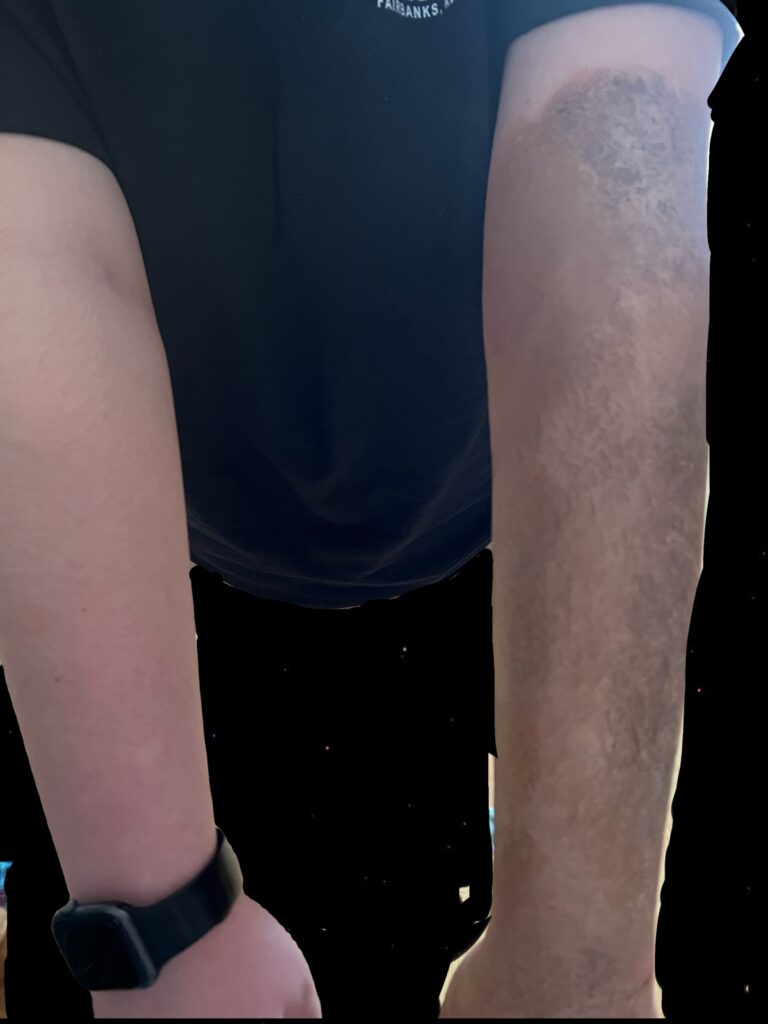Scleroderma is an autoimmune connective tissue that causes inflammation in the skin, blood vessels and can damage other areas of the body. There are a number of conditions that can cause scleroderma, such as rheumatoid arthritis, lupus, or Sjogren’s syndrome. It commonly affects the skin, making it hard and tight, but it can also affect organs. In my research, I found little information about why scleroderma occurs; the common theories are that it results from autoimmunity, genetics, and environmental factors. Although it is rarely ever found when not associated with certain autoimmune diseases. Scleroderma can be mild to severe. A milder form of this disease affects the skin and blood vessels due to the abnormal growth of connective tissue. This is called localized scleroderma. Resulting in the immune system malfunctioning, causing the fibroblasts it contains to produce too much collagen in the lungs, kidneys, and skin. The immune system does this because it thinks the tissues are damaged and is trying to repair them with lymphocytes. The lymphocyte is a white blood cell that contains killer cells, T-cells, and B-cells; it attacks the tissues activating apoptosis, the death of cells.
Connective tissue is made up of five significant cells: fibroblasts, mast cells, plasma cells, macrophages, adipocytes, and leukocytes. When the activated T-cells and the macrophages become infiltrated, the mast cells are degranulated in the skin. Directly correlating with the malfunctioning of connective tissue that begins to break down, thus causing it to thicken. Collagen takes up 65-80% of the dry weight of the tendons. When it starts to be overproduced, the tendons’ structure starts to change. The change in the tendons starts to affect the connective tissues, which then become inflamed, and the skin becomes tight and damaged. The connective tissue supports and protects other tissues and organs; because of this, people with scleroderma often have swollen blood vessels, rashes, and joint pain; in the worst cases, the organs can be affected.
Scleroderma affects women far more than men. These women are often between the ages of 30-50 and, more commonly, women of color. African-Americans develop scleroderma earlier than other races, and when they do develop scleroderma, it is often very severe and affects the organs, most commonly the lungs and heart, and can even cause lung disease. Scleroderma is separated into two groups, localized and systematic. Localized scleroderma appears either linear, where it is a thick scar-like line running along the body, most often on the face or legs, or morphea, which presents in patches on the skin, and in some cases, it appears as both. Systematic scleroderma can be a limited cutaneous scleroderma, which gradually affects the fingers, face, hands, lower arms, and legs below the knees. The other kind is diffuse cutaneous scleroderma, which spreads quickly, starting at the fingers and toes, then spreading to the upper arms and thighs. Diffuse cutaneous scleroderma is often the type associated with organ damage. The build-up of the connective tissue and collagen causes scleroderma to look like a rash-type scar, stretching and pulling on the skin.
References
Mayo Clinic. (2019). Scleroderma – Symptoms and causes. Mayo Clinic. https://www.mayoclinic.org/diseases-conditions/scleroderma/symptoms-causes/syc-20351952
Hou, W. (2011). Scleroderma. https://doi.org/10.1016/b978-0-443-06974-1.00014-2
Nancy Garrick, D. D. (2017, April 12). Scleroderma. National Institute of Arthritis and Musculoskeletal and Skin Diseases. https://www.niams.nih.gov/health-topics/scleroderma#:~:text=Scleroderma%20is%20an%20autoimmune%20connective
Takahashi, T., Asano, Y., Sugawara, K., Yamashita, T., Nakamura, K., Ryosuke Saigusa, Ichimura, Y., Toyama, T., Taniguchi, T., Kaname Akamata, Noda, S., Yoshizaki, A., Tsuruta, D., Trojanowska, M., & Sato, S. (2017). Epithelial Fli1 deficiency drives systemic autoimmunity and fibrosis: Possible roles in scleroderma. 214(4), 1129–1151. https://doi.org/10.1084/jem.20160247
In my photos below, I decided to use makeup to show what scleroderma looks like on the surface of the skin. I had tried to make my hand appear swollen, but it did not turn out well, so I decided not to use those photos.



In Kenna Marchesseault’s project titled Scleroderma, she wishes to dictate the causes, reactions and the pool of people in which are affected by this autoimmune disease through her artwork and abstract.
Scleroderma is a condition in which the body overproduces collagen causing it to overpopulate the longs, kidneys, heart, but mainly has an effect on the skin. It is an autoimmune invasive connective tissue. This is what Kenna focuses on. When an overproduction of collagen takes place, the body tries to repair it with lymphocytes, a white blood cell that has no intention but killing. It is important to note that collagen often takes up 65% or more of the dry weight in tendons. When the Lymphocytes begin to attack the collagen in the body, the structures of the tendons in the body start to change, further affecting the connective tissues. The two interact with each other, irritating the skin, inflaming it, then killing it, resulting in a thick, tight and tired layer of skin. There are three types of scleroderma: localized and systematic. Linear appears as a thick scar on the body, primarily on the face or legs while systematic affecting areas like the outer areas of the limbs and the face. There is also cutaneous scleroderma, which begins at the fingers and toes and spreads rapidly up the body and often results in organ damage.
Scleroderma mainly affects women, but can affect all people who meet the conditions. Scleroderma mainly affects women of color, and when it does, it has a fatal effect and attacks the organs like the lungs and heart.
Your artwork is absolutely amazing!
Ivana Brito